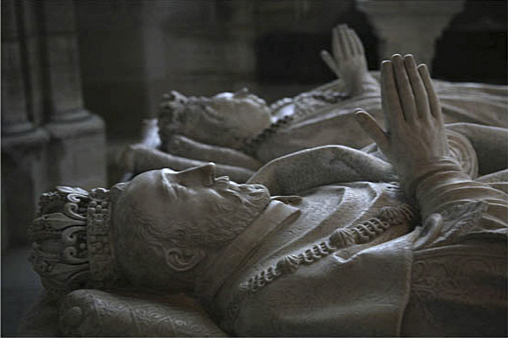
- Articles
The Death of Henry II of France
Abstract: On June 30, 1559, King Henry II of France (1519-1559), against the advice of his court ministers, participated in a fateful joust. The wooden lance of his younger opponent pierced the King’s headgear, shattered into fragments, and penetrated his right orbit and temple. The King survived for 11 days following the mortal wound and was treated by two of the most distinguished physicians of the Renaissance: Ambroise Paré (1510-1590), the master surgeon, and Andreas Vesalius (1514-1564), the great anatomist. The unfortunate event, the nature of the injury, and the medical consultation between these eminent physicians should all be of interest to neurosurgeons. The historical consequences of this event are briefly reviewed.
In the spring of 1559, King Henry II of France (1519-1559), his Florentine wife Catherine de Medici (1519-1589), and their royal progeny were poised and seemingly destined for glory.(Fig.1)
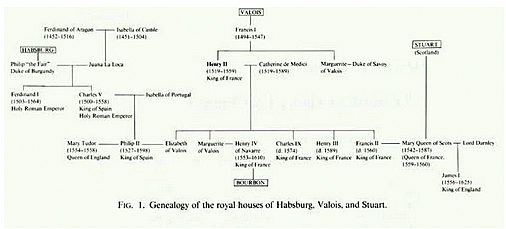
Their young son Francis II had married the spirited and attractive Mary Queen of Scots the previous year in an extravagant ceremony. Now the royal couple planned lavish festivities for the upcoming marriages of Henry’s sister Marguerite to the Duke of Savoy and his elder daughter Elizabeth to the pre-eminent monarch in Europe, King Philip II of Spain (1527-1598).* The ascetic Philip II was the son of the last duly crowned Habsburg Holy Roman Emperor Charles V (1500-1558), who commanded the most powerful and diverse dominion in Europe until his abdication in 1556. Henry II’s father, the troublesome Valois ruler, King Francis I of France (1494-1547), had thwarted the ambitions of Charles V for years. Besides Spain, France’s age-old enemy, Austria was ruled by Philip II’s uncle, Habsburg Emperor Ferdinand I (1503-1564).(12)
It would seem that these propitious royal marriages would herald a new era of prosperity for France. It was in this seemingly fortuitous setting that, in the summer of 1559, King Henry II was fatally wounded in a joust that changed the history of France and European civilization.(2, 5, 6, 8-10,15,16)
The story deserves recounting here because the mortal wound was an unusual penetrating craniofacial injury which should be of interest to practicing neurosurgeons in general and to those with a historical interest in particular.
The Traumatic Event
On June 30, 1559, King Henry II was celebrating the wedding by proxy** of his daughter Elizabeth to King Philip II at St. Quentin. For the long celebration, King Henry had arranged for a 3-day tournament, an unfortunate occurrence as destiny was to prove. The King, in fact, had been forewarned not to engage in jousts or in single combat, yet he insisted on such a joust with the Comte de Montgomery, Captain of the Scottish Guard. The forewarning had been given in 1558 by the physician-turned-occultist, Michel de Nostradamus (1503-1566), in a famous quatrain.
Nostradamus, a French physician of Jewish descent, was born in the town of St. Remy. He was schooled in the humanities at Avignon and subsequently graduated from medical school at the famed Montpelier, graduating “with great eclat.”(16) Nostradamus distinguished himself as a physician during the plague that broke out in 1546, spending 3 years treating those afflicted (this epidemic claimed his wife and two children). The people of the town of Aix were so moved and grateful for his work during those perilous times that they rewarded him with a modest pension. It was after he had remarried that he began to compose quatrains, short four-line prophetic enigmatic verses, written as epigrams during periods of solitude.(16) As a result of his gift for prophecy, he became Catherine de Medici’s court consultant in the occult. The famous quatrain he composed, which presumably prophesied the death of King Henry II, reads:
The Lion shall overcome the old
on the field of war in a single combat (duelle);
He will pierce his eyes in a cage of gold
This is the first of two lappings, then he dies a cruel death.(16)
As predicted by the quatrain, the King was mortally wounded. His younger opponent’s wooden lance pierced the King’s headgear, shattered into fragments, blinded him in the right eye, and penetrated his right orbit and temple (Fig. 2).(2)
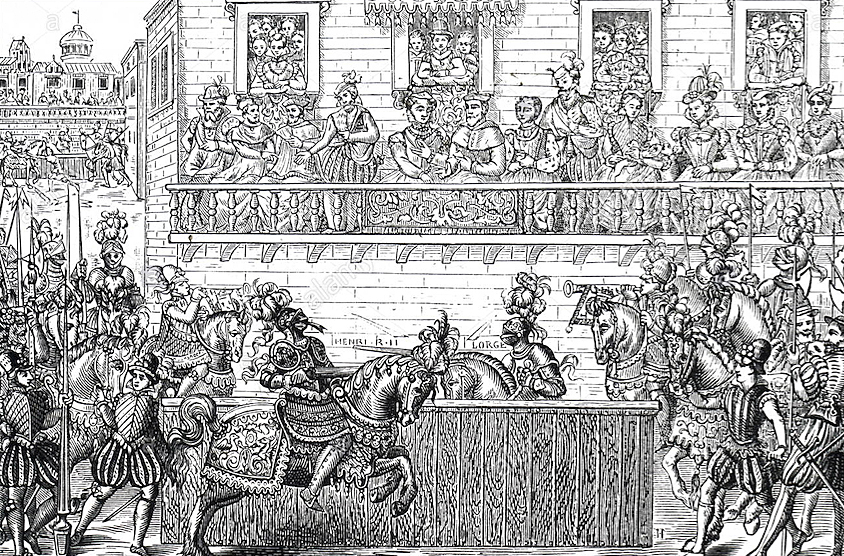
The King was obtunded. Noting contemporary observers, Andreas Vesalius wrote, “Upon receiving the wound, the King appeared about to fall first from one side and then from the other, but eventually, by his own effort, he managed to keep his saddle. After he had dismounted and was surrounded by spectators running forward from the crowd he showed loss of consciousness, although he later ascended the steps to his chamber with hardly a totter.”(17)

The Medical Consultation
The King was immediately treated by the court physicians*** with the prevalent remedies of the time and was attended by the most famous surgeon of France, Master Surgeon Ambroise Paré (1510-1590, Fig. 3).(13,4,9-11,18)
Upon hearing the news, King Philip II dispatched from Brussels one of his personal physicians, the great anatomist Belgian-born Andreas Vesalius (1514-1564, Fig. 4). Vesalius arrived for consultation on July 3, 1559.(15,17) It is said that Vesalius examined the King, performed a crude neck flexion maneuver which elicited meningismus, and determined that the patient would not recover.(15,17)
Wasting no time, Queen Catherine, in a desperate attempt to help determine the nature of the injury and find a cure for her husband, “had four criminals beheaded and broken truncheons thrust into the eyes of the corpses at the appropriate angle of penetration.”(14) Sadly, she also had the Comte de Montgomery executed. Realizing his predicament, the Captain of the Scottish Guard had made an unsuccessful attempt to escape.
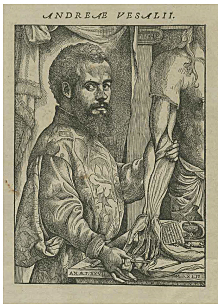
Another famous engraving from a woodcut (circa 1560), now at the National Library of Medicine at Bethesda, shows Henry II on his deathbed (Fig. 5). The King’s ministers, Queen Catherine, and the royal children are pictured at the bedside, while Vesalius and Paré perform a bedside consultation. The two famous physicians are depicted just behind the table positioned in the center of the room. During this famous consultation, trephination was discussed and rejected.(9,10,15,17,18)
According to Norwich,(15,17) “from the fourth day after the injury until his death, the King had a fever. Before death, his left arm and leg became paralyzed and a convulsion of long duration was observed on the right side of the body. Towards the end, respiration was very difficult and death occurred on the eleventh day.”
The following is what Vesalius recorded in his hastily written medical report (which included both the clinical history and the autopsy findings) after the King’s death:
Despite the fact that the left eye was immensely swollen, it retained full vision, indicating that there had not been a breakdown of the nervous force. The bone of the skull in the frontal region appeared completely uninjured and intact although there was an oedematous swelling of the forehead. The superior part of the nasal bone was not at all bare and had suffered from contusion rather than abrasion. The external side of the socket of the right eye was completely denuded of membrane and was rough. Its innermost and posterior aspect still contained a large number of splinters which, like stakes, had been driven in a kind of circle which chiefly occupied a position between the socket and the lower aspect of the eye. Their tips had penetrated the hard covering of the eye so that small splinters extended into it from as far as the superior part of the socket and the anterior region of the eye, which otherwise seemed uninjured and intact in content and appearance.
The membranes of the brain and the brain itself at the forehead and at the right socket of the eye, which one might believe could have been preserved only by extraordinary chance, appeared quite unharmed, and the dural membrane appeared everywhere uninjured. But the membrane attached to it somewhat posteriorly at the vertex had a yellowish color for the length of one finger, the width of two, and the depth of a thumb. The whole of the left part was observed to be filled with a serous ichor-like fluid which flowed away as if the whole had recently been affected by putrefaction or some sort of gangrene.
In the region where the suppuration occurred, the dural membrane was observed to have vessels more distended and blackish than elsewhere, but between this structure and the skull there was some grumous blood. The skull and the skin that, as may already have been conjectured, had been scraped off, showed nothing abnormal, although at some time, as a scar indicated, the king had been wounded there. Thus the putrid condition gave proof that the brain had collided with the skull and had been concussed and shocked by it, and not that the condition had been caused by an injury to the skull.(17)
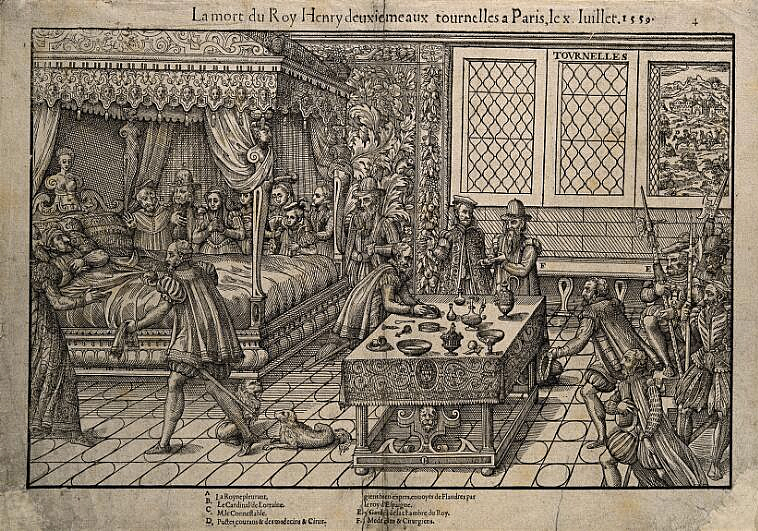
Thus Vesalius, presumably familiar with Paré’s writings (and Paré himself being present during the discussion), was aware of contrecoup injury to the brain. The possibility of subdural hematoma was not only entertained by Vesalius but also mentioned by others, including Walker,(22) O’Malley,(17) and Norwich.(15) Furthermore, Norwich speculated that, likely, “infection had set in, spreading from the wound in the eye through the ophthalmic veins into the cavernous sinus and resulting in a large cerebral abscess.”(15) This is a distinct possibility given the King’s fever, meningismus, and autopsy report. Cerebritis with the subsequent development of an intraparenchymal abscess would have been more likely to be present in the traumatized area more posteriorly in the left hemisphere where the proposed contrecoup injury occurred. It is also possible that the King had an associated subdural hematoma as suggested by the aforementioned authors; one could also add to the differential diagnosis the possibility of a subdural empyema because this process would have explained the fever, meningismus, herniplegia, and seizures and could still be reconciled with the autopsy findings.
Even in the face of this diagnosis, there were serious reservations against a favorable prognosis for the King’s recovery, even if he had undergone trephination. Although it is a fact that Paré had ample experience with trephination for skull fractures on the battlefield, to our knowledge he had not trephined for closed intracranial (intraparenchymal) mass lesions, especially where the diagnosis was seriously in doubt.(1,3,4,9-11,18-19) Moreover, trephining during the Renaissance was understandablyundertaken with great trepidation.(9-11,13,20) Walker(22) mentions that, even when subdural collections of pus were suspected, they were usually fatal “due to the fear of incising the dura mater.” In my opinion, medical science was not yet capable of providing the intensive medical care that was necessary to successfully treat such a complicated injury.(9-11)
The Aftermath
Nostradamus miraculously escaped the wrath of Queen Catherine. In fact, he continued to be favored by the Queen and was regaled splendidly in court. The fulfilled prophesy actually enhanced his career as an astrologer and occultist.**** He later predicted the date and time of his own death (July 2, 1566).(7,16)
Paré went on to win the hearts of the French people, the poor and disadvantaged as well as the rich and privileged. He married, had children, and attained fame and fortune. He died at the age of 80 years, but not before successfully persuading the stubborn Archbishop of Lyons to surrender to Henry of Navarre (1553-1610), thus bringing an end to the civil strife that had been ravaging France. Henry of Navarre triumphantly entered Paris, converted to Catholicism (stating, “Paris is worth a mass”), and became Henry IV. He was the first Bourbon King and is fondly remembered as one of France’s greatest kings. He signed the “Edict of Nantes” granting religious toleration and political equality to Protestants.(5,12) Near death, Paré bequeathed to his family “his wealth, property and honor” and to physicians and academicians “a burning against mystification and the Ivory Tower.”(3)
Vesalius, on the other hand, had a relatively short and unhappy life. He died before his 50th birthday on the island of Zykanthos (or Zante) while returning from a penitent pilgrimage to Jerusalem.(11) Nevertheless, posterity has remembered him well for his anatomical masterpieces and his scientific legacy purveyed in his magnum opus, De Humani Corporis Fabrica (1543).(21) Vesalius is now considered the “Father of Anatomy,” and a famous engraving of him at 28 years of age illustrates or adorns many texts and manuscripts on medical history.(9-11,13-14,17,21)
Queen Catherine became virtual ruler of France, governing as regent from 1560 to 1574 in the style of de Medici (or the Borgias). She instigated the infamous St. Bartholomew’s Massacre on August 24, 1572.(1,3,4) She died in 1589, at 69 years of age, after wielding considerable power in European affairs. Recent historians have exonerated her from many of the ignominious acts of which she had been accused.(5,6)

As predicted by Nostradamus in a very “couched and enigmatic manner” for personal protection,(16) Catherine’s royal progeny (Fig. 1) had “brief, unfulfilled reigns.” Francis II, husband of Mary Queen of Scots, died young in 1560. Charles IX, who provided shelter and hid Paré in his own bedchamber during the massacre of French Huguenots on St. Bartholomew’s Day, died of tuberculosis in 1574 at 24 years of age. The last male sibling, the promising Henry III, was stabbed by a demented monk in St. Cloud in 1589. His death precipitated the civil crisis in which Paré intervened just prior to his death, saving France from further chaos.
In the long run, the death of King Henry II destabilized the European balance of power. After his death, the ensuing religious wars and internal strife provided an opportunity for France’s mortal enemy, Catholic Spain, the foremost power in Europe in those days, to conceive, plan, and finally launch its Armada against Protestant England.(8) The defeat of the supposedly “Invincible Armada” heralded the end of the “Siglo de Oro” for Spain and the beginning of the “Century of Genius” for England, Holland, France, and Germany.(5,8) With the destruction of the Spanish Armada and the end of the religious wars in France, England and France, not Spain and Italy, would now play a more decisive and pivotal role in the course of Western civilization and human history.
Acknowledgments
My thanks go to the medical library staff, as well as to Mrs. Faye Frazier of Media Services (photographs), at the Mercer University School of Medicine for their indispensable assistance in the compilation of data for this manuscript and to my wife, Helen, for her typing and review of the text. I am grateful to Mrs. Barbara Lyons for permission to use the illustrations from the magnificent book, Medicine: An Illustrated History by A. S. Lyons and R. J. Petrucelli.(13) My appreciation is extended to I. Norwich for making me aware of the existence of Vesalius’s medical report, “The Tragic Termination of the Royal Injury.” The original medical report is housed at the Bibliotéque Nationale, Paris, but for interested readers a copy is conveniently reproduced in O’Malley’s comprehensive book, Andreas Vesalius of Brussels, 1514-1564.
Footnotes
* In England, Mary Tudor (1516-1558),Queen of England, died suddenly in 1558making her husband, King Philip II, a widower and eligible for remarriage. (Mary Tudor, nicknamed “Bloody Mary,” should not be confused with Mary Queen of Scots, who was briefly married to Henry II’s young son Francis II. Mary Queen of Scots, who was also a legitimate claimant to the English throne, was beheaded by Queen Elizabeth I in 1587 at Fotheringhay Castle.)
** The celebrated Spanish general, the Duke of Alba, took King Philip’s place for the ceremony. The King was in Flanders concluding a peace treaty with the rebellious Dutch who had defied his imperial rule.
*** Even the illustrious Spanish physician Dionisio Daza Chacón (1510-1596), who had accompanied the Duke of Alba as part of the royal entourage, was in attendance.
**** Nostradamus, perhaps the most famous astrologer of all time, composed many other quatrains which are said to have foretold world events for 500 years. Recent scholars contend that other quatrains presaged the French Revolution in the late eighteenth century, the exploits of Napoleon Bonaparte in the early nineteenth century, and even the rise and fall of Adolph Hitler in the twentieth century. Certain quatrains are claimed to prophesy Armageddon and the second coming of Christ.
References
I . Bagwell CE: Ambroise Paré and the renaissance of surgery. Surg Gynecol Obstet 152:350-354, 1981.
2. Barber R, Barker J: Tournaments, Jousts, Chivalry and Pageants in the MiddleAges. Woodbridge, Kent: Boydell Press, 1989, pp 134 and 139.
3. Bendiner E: From barbershop to battlefield — Paré and the renaissance of surgery. Hosp Pract (August): 193-225,1983.
4. Bloch H: Ambroise Paré (1510-1590): father of surgery as art and science. South Med J 84:763-765, 1991.
5. Brinton C, Christopher JB, Wolff RL: A History of Civilization, ed 3.New Jersey: Prentice Hall, 1976.
6. Cleugh J: The Medici.New York: Dorset Press, 1990, pp. 292-308.
7. Cohen D: The Encyclopedia of the Strange.New York: Dorset Press, 1985, pp 143-152 and 205-213.
8. Creasy ES: Fifteen Decisive Battles of the World. From Marathon to Waterloo. New York: Dorset Press, 1987, pp 227-251.
9. Faria MA: The forging of the Renaissance physician: a philosophic and historic perspective. Parts I and 11. J Med Assoc Ga (March): 119-126, 1992.
10. Faria MA: The forging of the Renaissance physician: a philosophic and historic perspective. Parts III and IV. J Med Assoc Ga (April): 165-176, 1992.
11. Haeger K: The Illustrated History of Surgery, ed 1. New York: Bell, 1988 (Edited and translated by JV Leuven).
12. Harvey D, Fehrenbacker DE (eds): The Illustrated Biographical Dictionary, ed 3.New York: Dorset Press, 1990.
13. Lyons AS, Petrucelli RJ: Medicine: An Illustrated History.New York: Harry N. Abrams, 1978 (Edited by W Rawls).
14. Newman A: The Illustrated Treasury of Medical Curiosa. New York: McGraw-Hill, 1988, p 67.
15. Norwich I: A consultation between Andreas Vesalius and Ambroise Paré at the deathbed of Henry II, King of France, 15 July 1559 [sic]. South African Med J 80:245-247,1991.
16. Nostradamus M: Prophesies(1558). Basel, and reproduced in New York: Crown, 1980.
17. O’Malley CD: Andreas Vesalius of Brussels, 1514-1564.Berkeley, Calif-University of California Press, 1964, pp 287-288 and 396-398.
18. Paget S: Ambroise Paré and His Times, 1510-1590. New York: G.P. Putnam’s Sons, 1897.
19. Paré A: Apologie and Treatise.Chicago: University of Chicago Press, 1952 (Edited by G Keyes).
20. Simpson D: An awareness of tragedy. Childs Nerv Syst 3:135-139, 1987.
21. Vesalius A: De Humani Corporis Fabrica Libri Septem.(Basel: Oporinus, 1543) Bethesda: National Library of Medicine, 1964.
22. Walker AE: A History of Neurological Surgery.New York: Hafner, 1967, p 17.
Dr. Faria is Editor emeritus of the Medical Sentinel and author of Vandals at the Gates of Medicine (1995), Medical Warrior: Fighting Corporate Socialized Medicine (1997), and Cuba in Revolution: Escape From a Lost Paradise (2002).
(Originally published in the Journal of Neurosurgery Dec. 1992; 77 (6): 964-969. Copyright©1992 Association of American Neurological Surgeons (AANS).)